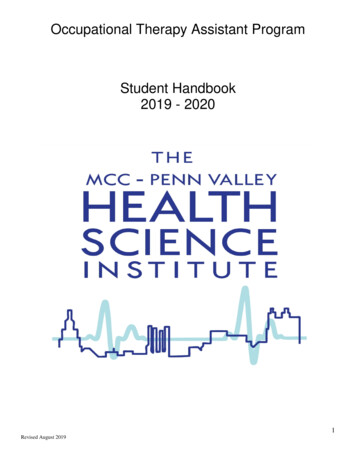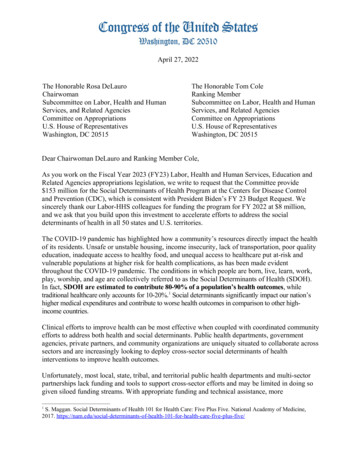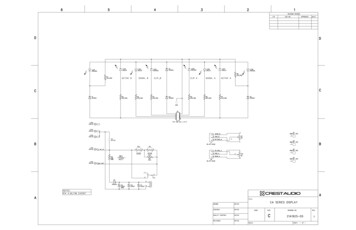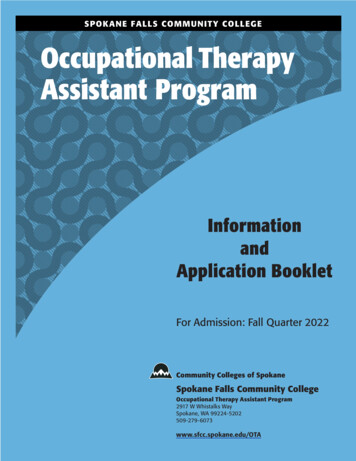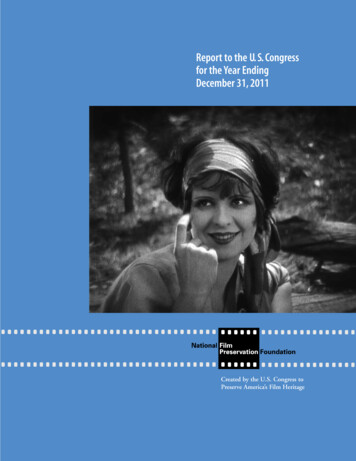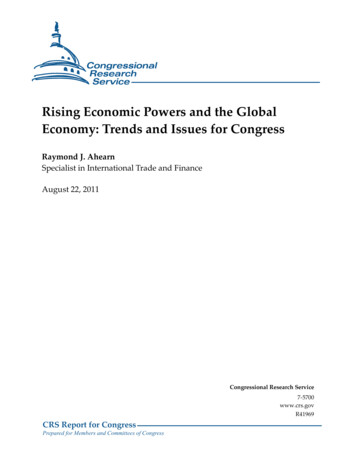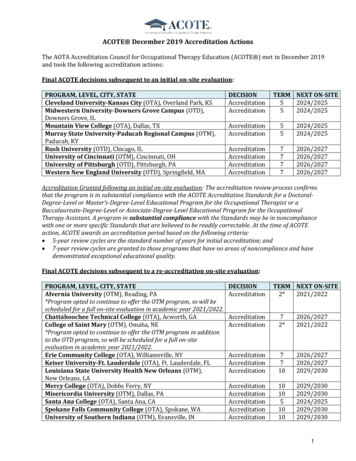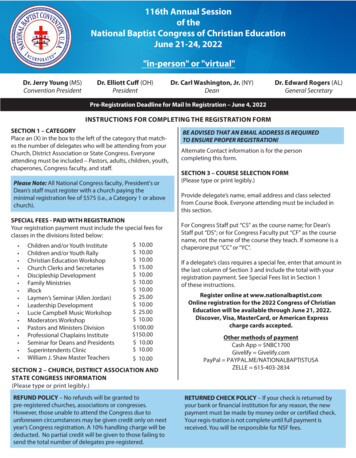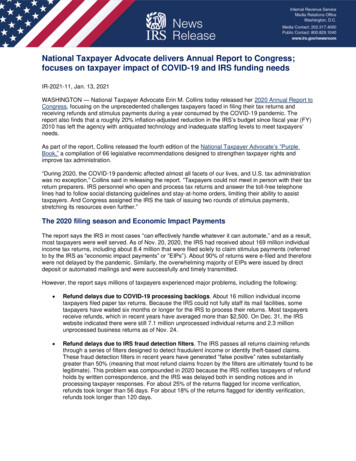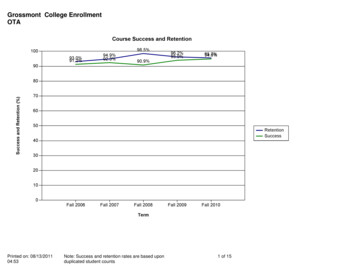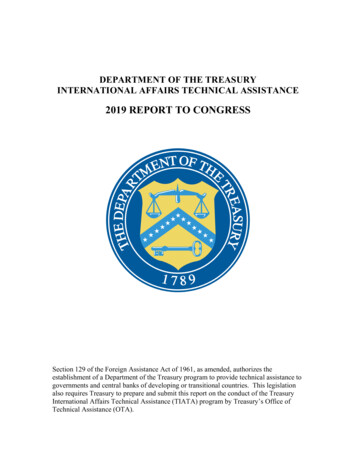
Transcription
DEPARTMENT OF THE TREASURYINTERNATIONAL AFFAIRS TECHNICAL ASSISTANCE2019 REPORT TO CONGRESSSection 129 of the Foreign Assistance Act of 1961, as amended, authorizes theestablishment of a Department of the Treasury program to provide technical assistance togovernments and central banks of developing or transitional countries. This legislationalso requires Treasury to prepare and submit this report on the conduct of the TreasuryInternational Affairs Technical Assistance (TIATA) program by Treasury’s Office ofTechnical Assistance (OTA).
TABLE OF CONTENTSI.Introduction and Executive Summary1II.Program Organization and Principles2III.Project Allocation and Funding3IV.Project Selection and Assistance Delivery5V.Program Evaluation and Monitoring7VI.Achievements9VII.Special Focus: Information Systems Security Capacity Building13Annex 1: U.S. Treasury Strategic Plan 2018-2022 (Strategic Objective 2.3:Foreign Technical Assistance)15Annex 2: OTA Strategic Plan 2016-202017Table A - 2019 TIATA Budget Execution Plan19Table B - 2019 Non-TIATA Sources of Funding24
I.Introduction and Executive SummaryThis report provides an overview of the activities of the Treasury Department’s Office ofTechnical Assistance (OTA) for calendar year 2019. The report covers programorganization, funding, and the process for selecting and implementing projects, describeschanges in the program’s global footprint, and summarizes project-specific highlights.For 30 years, OTA has helped finance ministries and central banks of developing andtransitional countries strengthen their ability to manage public finances effectively andsafeguard their financial sectors. Such assistance is in the U.S. national interest. Strongeconomic governance regimes support financial sector stability, growth, and theachievement of broader U.S. foreign policy and national security goals. Developingcountries that generate more domestic revenue and manage their resources effectively areless dependent on foreign aid. Additionally, governments that develop effective financialsector oversight regimes are valuable partners in the global effort to combat moneylaundering and terrorist financing.In 2019, OTA supported financial sector strengthening in many regions and countries.As discussed in greater detail in section VI, OTA projects in Africa (e.g., Sierra Leone),Asia (e.g., Mongolia), Latin America (e.g., Colombia), and Eastern Europe (e.g.,Ukraine) helped mobilize revenues, deepen domestic bond markets, increaseinfrastructure finance, strengthen budget systems, improve banking supervision, andcombat economic crimes. In the area of infrastructure finance, OTA’s work in Panamacomplemented U.S. efforts to promote energy infrastructure investment throughout theWestern Hemisphere as part of the America Crece initiative.Strengthening information technology and systems was also an important element ofseveral OTA projects in 2019, including in Moldova where OTA supported the taxadministration’s first-ever information technology security audit. OTA similarly assistedcounterparts in countries such as Jamaica, Peru, and the Philippines in improving thefunctionality and security of critical information systems. More information on theseprojects is included in section VII of this report.OTA’s work supports Treasury’s strategic goal of promoting financial stability globally.As described in Treasury’s Strategic Plan for 2018-2022, OTA provides “technicalassistance to enable foreign partner countries to better raise and manage financialresources and protect their financial sectors.” This work entails focusing on OTA’s fivecore program disciplines (revenue policy and administration; budget and financialaccountability; government debt issuance and infrastructure financing; banking andfinancial services; economic crimes) as well as high-priority cross-cutting objectives suchas domestic resource mobilization, infrastructure finance, expanding access to financialservices, strengthening anti-money laundering/combating financing of terrorism(AML/CFT) frameworks, and supporting growth and rising median real incomes. (SeeAnnex 1: U.S. Treasury Strategic Plan 2018-2022.)1
II.Program Organization and PrinciplesOTA is organized along functional lines, operating in five major disciplines to assist thegovernments of developing and transitional countries: Revenue Policy and Administration: Creates more effective tax administrationsthat simplify procedures to encourage voluntary compliance on the part of taxpayers,effectively uncover tax evasion, and maintain high standards of fairness andtransparency. Budget and Financial Accountability: Strengthens all phases of the governmentalbudget cycle, including budget formulation, execution, monitoring and reporting,treasury operations, and evaluation. Government Debt and Infrastructure Finance: Provides strategic and technicalassistance to develop market-based means of public finance through the issuance ofdomestic government securities; increases the efficiency of government debtmanagement; implements comprehensive debt strategies that diversify sources offinance, reduce liability risk and lower debt service burdens; strengthens enablingenvironments for private investment; and accelerates the development of financiallysound infrastructure projects. Banking and Financial Services: Supports the development of strong financialsectors in which institutions are well-regulated, stable and accessible, serve asefficient intermediaries between savers and investors, and are resistant to criminalactivity. Economic Crimes: Assists the development and implementation of AML/CFTregimes that are compliant with international standards.In providing technical assistance, OTA follows a number of guiding principles: OTA supports self-reliance. OTA provides countries with the knowledge and skillsrequired to move towards financial self-sufficiency—including the capability togenerate and better manage their own government finances—and to reducedependence on international aid. OTA generally follows a three- to five-year projectcycle that is aimed at creating maximum impact and exiting when local capacity hasbeen created. OTA is selective. OTA works with governments that are committed to reform—reform that they design and own—and to using U.S. assistance effectively. OTA isrecognized for supporting country ownership; achieving alignment with host countrypriorities; managing for development results; and fostering mutual accountabilitywith host country officials. OTA does not engage with a country without a signedbilateral Terms of Reference that sets out the high-level terms and aims of theengagement, followed by a tactical-level work plan specifying activities in support ofthose aims. OTA works side-by-side with counterparts. OTA engagements are based on closeinteraction between advisors and working-level partners, whether in a financeministry, central bank, financial intelligence unit, tax administration, or other relevantgovernment agency. OTA advisors introduce sound practices in daily work routinesthrough ongoing mentoring and on-the-job training.2
III.Project Allocation and FundingAs of the end of 2019, OTA had 88 bilateral technical assistance projects in 48 countries.Thirty-six percent of OTA’s total projects in 2019 were in the Americas, 22 percent werein Asia, 30 percent were in Sub-Saharan Africa, 10 percent were in Europe and Eurasia,and 2 percent were in the Middle East and North Africa (see chart below). The totalnumber of projects and their regional distribution are consistent with OTA’s footprint inrecent years, with marginal decreases in project footprints in the Americas and Asia, aslong-standing engagements ended in Afghanistan, Burma, Cambodia, Colombia,Dominican Republic, and the Philippines.OTA strives for depth of engagement and an integrated, multi-discipline approach. Thisapproach recognizes the complex, systemic nature of public financial management andthe importance of engaging with a counterpart government in various disciplines in acoordinated way to achieve the greatest possible impact. In 2019, out of OTA’s 48country engagements, 22 involved experts from two or more disciplines.Chart 1 - OTA Projects by Region 2019OTA received total funding of 52.3 million in 2019, including funds directlyappropriated to the program and transfers from other U.S. agencies. OTA’s direct annualappropriation, formally known as “Treasury International Affairs Technical Assistance”or TIATA, was allocated to support a total of 92 bilateral assistance projects and 10subject matter-specific senior advisors (who work regionally and globally) with acombined budget of 50.3 million. TIATA is a multi-year appropriation, which allowsOTA to fund projects through a combination of new and carryover funds.As the chart below indicates, TIATA is the single largest resource available to OTA forpursuing its mission. In FY 2019, Congress appropriated 30 million in TIATAresources. This level of funding helped maintain program continuity despite uncertaintywith respect to the availability and timing of interagency transfers and enabled the3
program to initiate engagements in priority assistance areas, including AML/CFT,spurring domestic resource mobilization, and increasing access to finance.In addition to TIATA funding, OTA receives resources from other agencies, such as theU.S. Department of State and the United States Agency for International Development(USAID). Funding transferred to OTA from other agencies in 2019 totaled 22.3million, which is line with average transfer amounts over the previous five years. Theprogram continues to monitor closely the level of funding it receives—both TIATA andtransfers from other agencies—to ensure that it is sufficient to sustain the current level oftechnical assistance OTA delivers globally and to respond to new and emergingpriorities.Chart 2 - OTA Funding by Source FY 2015-FY 2019Notes1. Details may not add to totals due to rounding.Tables A and B at the end of this report provide additional data regarding the allocationof OTA funding sources in 2019, including funds received as transfers.4
Program ManagementProgram management is the set of management and administrative activities and relatedcosts that OTA requires to effectively develop, deliver, and oversee technical assistanceto partner countries globally. These costs, which are largely associated with OTA’sheadquarters management and administrative functions, include compensation forprogram office management and staff; headquarters office facility and maintenance,utilities, and other services (e.g., computer, telephone and internet, supplies);procurement and financial management services; and office and information systemssecurity. These program management expenses are funded by twenty percent (20%) ofall funds the program receives, whether via direct appropriation (TIATA) or inter-agencytransfer.IV.Project Selection and Assistance DeliveryTwo of the most frequently asked questions about OTA’s work are: “How are projectsselected?” and “How is assistance delivered?” Project selection is a process that typicallybegins with a request for Treasury technical assistance as outlined below and is informedby a careful assessment of a project’s potential for impact and success. Assistance isdelivered via a resident advisor or intermittent advisor-based project model, or acombination of both. Project documentation, in particular agreed Terms of Referenceand progress reports, is a vital part of the assistance architecture.Receiving and Assessing Requests. Requests for technical assistance and informationregarding potential projects come from many sources, including U.S. embassies, USAIDmissions, other Treasury offices, foreign governments, and international organizationssuch as the IMF, as well as from OTA advisors already on the ground implementing otherprojects.For requests that OTA determines to be within its mandate, an on-the-ground assessmentis carried out by OTA subject matter experts. The OTA subject matter expert shares theassessment’s conclusions with the partner government and the U.S. embassy in the hostcountry. OTA looks to its host-country counterparts to define project goals from theoutset. Experience shows that goals and objectives that are not “owned” by thecounterpart are seldom achieved.If the on-the-ground assessment is favorable, the manager of one of OTA’s five coredisciplines submits a project proposal based on the assessment to the OTA Director andDeputy Assistant Secretary for Technical Assistance Policy. Decisions about whether tobegin new projects, or to continue or terminate existing projects, are based on criteria andconsiderations that include: the need for technical assistance; evidence of counterpartcommitment to reform and good use of assistance; whether the project wouldcomplement other projects in a particular country or region; the relation of the project toTreasury’s policy priorities and broader U.S. Government goals; and the availability offunding. In the course of assessing the prospects for a given project, OTA consults withother Treasury offices, and other partners and stakeholders such as the U.S. Department5
of State and USAID (in the field, at the embassy level, and at the headquarters level inWashington), the IMF, and the World Bank.Assistance Delivery Models. OTA carries out technical assistance through two basicdelivery models: a resident advisor-based project and an intermittent advisor-basedproject. A resident advisor-based project is anchored by an expert advisor living in thecounterpart country, typically for a period of several years, and working side-by-side withofficials in the ministry of finance, central bank, tax administration authority or othergovernment institution. Treasury has found that working directly with the counterpartover a sustained period of time is critical for transferring knowledge and strengtheningsystems, especially in countries where government capacity is very limited. In additionto a resident advisor, a resident project frequently includes the participation ofintermittent OTA experts in specialized areas who make short-term visits.For an intermittent advisor-based project, a group of several advisors typically spends atotal of 30 to 45 weeks per year over the course of several years, in periods of two tothree weeks at a time, working with host-country counterparts. In between these multiweek direct engagements, the counterparts are expected to carry out planned activitiesthat are directed toward the objectives stated in a mutually-agreed-upon work plan.Between trips, advisors and counterparts are in frequent contact by email and phone.OTA often hires a permanent, full-time program assistant in-country to support theintermittent project.Whether OTA selects a resident or intermittent advisor-based project model depends onthe extent and nature of the problems to be solved, and the most practical solutions tothose problems. Typically, one resident advisor will be utilized to cover a single largesubject area, such as program budgeting or debt management, that will require severalyears to complete. Alternatively, an intermittent advisor-based project will use severaladvisors to cover a multitude of specialized assistance topics, such as audits, arrearscollection and strategic planning in tax administration, or financial intelligence unitdevelopment, techniques of financial analysis, investigation and prosecution, or assetmanagement, seizure and forfeiture.Project Documents. Once OTA selects a resident or intermittent advisor project forfunding, Terms of Reference (TOR) are developed with the counterpart agency andsigned by a policy-level official from the counterpart government and Treasury’s DASfor Technical Assistance Policy. The TOR describe the broad goals of the project andrepresent a bilateral understanding at the policy level between OTA and the hostinstitution. Within a short period (normally six to eight weeks) after signing the TOR, adetailed work plan is agreed upon between the advisor assigned to the project and theworking-level counterpart. This workplan, which is approved by the Associate Directorfor the relevant OTA team, specifies objectives, planned completion dates anddeliverables, and is the primary basis for regular monthly progress reports to Treasuryheadquarters.6
The monthly reports are shared with counterpart institutions, U.S. embassy staff, otherbureaus and offices in Treasury, and other interested partners such as USAID, theMillennium Challenge Corporation, and the relevant International Financial Institutions.OTA uses the reports as a management tool to oversee the progress of the project and tomake any necessary changes. The reports also form the information base for responses toproject queries from U.S. Government officials. In addition, supervising officialsconduct field visits to meet counterparts and advisors and review the project’s progress.Such visits and reviews are conducted, generally, on an annual basis.V.Program Evaluation and MonitoringOne of the most important managerial functions in any assistance program is to monitorand evaluate individual projects and the overall program. OTA monitors projectperformance using a variety of methods, including on-site evaluations by OTA managers,written monthly reports prepared by advisors that describe progress on work planobjectives, and end-of-project reports which provide a final assessment of projectoutcomes. An OTA expert other than the project implementer undertakes end-of-projectreports, which are conducted typically within three to six months following the end of theproject. The purpose of these reports is to better understand the program’s longer-termimpact. OTA completed seven end-of-project reports in 2019.In addition, once a year OTA conducts an exercise to measure the level of “traction,” orthe degree to which changes in partner governments’ behavior occurs as a result of OTAassistance (e.g., the number of foreign officials who are taking an active role in pursuingchange, or interim deliverables that are on time or ahead of schedule). OTA alsomeasures “impact” (the extent to which the objectives are actually achieved) for eachtechnical assistance project. The levels of traction and impact are measured by OTAadvisors and headquarters staff according to specific indicators that are relevant to eachof the five OTA financial disciplines. For example, revenue team indicators includeadoption of modern functional processes and procedures, and adequacy of investigationand adjudication of internal conduct matters by the tax agency.For 2019, the baseline targets for OTA’s traction and impact were set using a 5-pointscale (with 5 representing the highest possible traction and impact), at 3.6 and 3.1,respectively. While OTA aims for maximum success for each project, the baselinetargets reflect a reasonable expectation of project traction and impact taking intoconsideration the inherent challenges of achieving a meaningful engagement with foreignpartners that leads to tangible outcomes. OTA met performance goals for traction in2019 with an actual score of 3.6. OTA’s impact score declined slightly to 2.9 butremains in line with historical averages. (See rating scale below for additionalexplanation of the meaning of these scores.)7
OTA Traction and Impact Evaluation Rating ScaleTraction5 – Advisors have regular and frequent meetings with counterparts. Counterparts display high levelsof involvement. There is an excellent professional relationship between the advisor and thecounterpart. Schedules are kept. Counterparts take the initiative to advance the project work. There isa great deal of energy and activity devoted to this objective.3 – While there is interaction and involvement in working on this objective, more focus and activitywould be desirable and is probably possible. For good and valid reasons the specific projectobjective does not have a high priority for the counterparts at the present time, but some importantand worthwhile efforts are being made. The project is doing well but could do better on thisobjective.1 – There is little if any involvement or activity generated around this objective. It may be that theobjective has been delayed, suspended, or otherwise given low priority. Though this may change inthe future, for the time period covered by this evaluation this objective is dormant.Impact5 – This objective has been completed and/or is having a noticeable and positive effect. The workbeing accomplished makes a difference that all involved in the project recognize and value. Theproject is making substantive and substantial differences that can be verified by any observer whounderstands the technical nature of this work.3 – Though the effects of this objective are unmistakable and positive, the objective was designed toachieve more than has been done to date.1 – There has been little if any substantive achievement or change as a result of work on thisobjective. It may be because little work has been done to date; because what has been done has beeninadequate; or because what was done failed.Use the numbers 4 and 2 to indicate levels of Traction and Impact between 5 and 3, or 3 and 1, if thatbest reflects the professional assessment of the evaluator.In accordance with the Foreign Aid Transparency and Accountability Act, OTAcontinues to strengthen its ability to measure the results of its technical assistanceprojects. This involves documenting project goals, activities, outputs, and outcomes inlogical frameworks and conducting independent (third-party) evaluation of OTA projects.Once the new regime is fully implemented, each OTA project would be subject to anindependent evaluation at its midpoint (generally after the second year of technicalassistance activities) and 6-12 months after a project concludes. Evaluations will seek todetermine the extent to which project goals were achieved. The results of evaluations willbe made available to the public as required by the FATAA.8
VI.AchievementsAs described in the previous section, Treasury measures the results of technicalassistance on a project-by-project basis, ranging from engagements that meet--or in somecases exceed--project objectives, to those that underperform, or result in little or noimprovement. On the latter, projects can fall short of expectations for a variety ofreasons: limited absorption capacity by recipients, a change in host-country leadership,difficulty in establishing a good working relationship between the advisor and his/hercounterpart, a lack of commitment to reform, or reform fatigue.OTA management conducts quarterly reviews of project progress. For projects with lessthan satisfactory progress, OTA may curtail or end the projects earlier than expected. Onaverage, OTA curtails or ends early 4-5 projects, roughly 6% of TIATA-funded projects,per year. This has been the case since at least 2017 when OTA began collecting data onthis on an annual basis. In 2019, five of the 92 bilateral assistance projects that theprogram approved using TIATA funds were ultimately curtailed or ended early due topoor performance. In addition, OTA terminated projects in The Gambia (3) and Burma(3) due to restrictions on assistance to those countries under the Trafficking VictimsProtection Act (TVPA).By contrast, OTA projects are successful when the foreign counterparts—at both thetechnical and policy level—are committed to reform and to using Treasury technicalassistance well. In 2019, a number of OTA partner countries demonstrated suchcommitment and made significant achievements with OTA assistance. Notableaccomplishments include the following:Budget and Financial AccountabilitySierra Leone Consolidates Cash Management. With OTA assistance, Sierra Leonedefined a new business model for its current Treasury Single Account (TSA) operation sothat its control mechanisms could be employed across all government entities. Prior tothis project, 76 agencies were operating outside the central government cash controlsystem. OTA led the efforts of the Accountant General, the Ministry of Finance BudgetOffice, and the Central Bank to define a new bank account structure to control allrevenues received and payments made by the government, define changes to the day-today procedures required to implement this new bank account structure, and document theprocedures in an operations manual distributed to spending agencies. Nearly all of the 76agencies that had previously operated outside the cash control system have now beenincorporated into the TSA.Paraguay Implements Payment Cards. With assistance from OTA, the ParaguayanMinistry of Finance is improving transparency and security by launching a new purchasecard program to replace petty cash. The Ministry of Finance, through the DirectorateGeneral of Public Treasury and the Directorate of Administration, implemented purchasecards in September 2019 as a pilot project which is now being implemented in all centralgovernment agencies. Through an agreement signed with the National Development9
Bank, cards are issued at no cost to the government, and ministries are required to use thecards for at least 50% of purchases initially. Ministries have until June 2020 to beginusing the cards.Dominican Republic Improves Fiscal Transparency. With OTA assistance, theDominican Republic updated and relaunched the government’s fiscal transparency portal(FTP). The country is now one of only five governments that publish budget informationaccording to the international Open Fiscal Data Package Standard. OTA assisted indeveloping FTP outreach and education plans. As a result of this effort, more than 70percent of Ministry of Finance personnel were trained and quarterly demonstrations wereconducted for journalists, civil society organizations, and university faculty and students.OTA also supported a visual redesign of the portal and new software for businessintelligence reports.Revenue Administration and PolicyMoldova Completes IT Security Audit. The internal audit unit of the Moldovan taxadministration completed its first information technology security audit, evaluatingauthorization, authentication, and audit logging controls for the wealth tax system. OTAprovided guidance on selecting, planning, conducting, and reporting audit assignments,determining data needed to support audit objectives, and obtaining and analyzing data.The initial audit found problems in nine of twelve controls reviewed. The internal auditunit will use the OTA-developed techniques as it audits additional tax administration ITcomponents, while the IT development department takes actions to address the findingsand recommendations. Ultimately, the improvements will safeguard mission-criticalinformation systems and better protect taxpayer data.Ukraine Bolsters Review of International Tax Transactions. In Ukraine, OTA helpedthe State Tax Service (STS) build its international audit and transfer pricing program andestablish a dedicated Transfer Pricing Unit (TPU) within the Large Taxpayer Office.OTA delivered a combination of classroom-based and on-the-job training to all transferpricing auditors. Transfer pricing refers to methods of determining prices of transactionsbetween branches of multinational firms. The STS has developed its first advancepricing agreements (APAs) with two multinational companies that, when approved, willdetermine the taxpayers’ transfer prices, providing greater certainty for the taxpayer andallowing the STS to direct resources to cases with potential transfer pricing abuse.Guyana Initiates Audit of Petroleum Industry. In 2019, OTA continued guiding theGuyana Revenue Authority (GRA) in developing and implementing an organizationalstructure, staffing plan, and audit training programs for its new Petroleum Revenue AuditUnit. Guyana began oil production in December 2019, five months ahead of schedule.GRA faces considerable pressure to build capacity in oil and gas auditing required toaccurately and effectively administer these revenues. The GRA has prioritized buildingthe unit through increased staffing and funding levels.10
Government Debt and Infrastructure FinancePanama Improves Outlook for Investments in Energy Infrastructure. OTA workedwith Panama’s electric utility, ETESA, to develop a strategy to improve its credit rating.This strategy, coupled this with ETESA’s solid financial performance and economicimprovements in Panama, contributed to achieving a credit rating improvement of twonotches. The new rating will result in debt service savings of up to 47 million on the 500 million bond ETESA issued in 2019. The improved credit rating also raised theattractiveness of ETESA-backed projects to international investors, which will raise thelevel of competition for Panamanian transmission infrastructure projects.Honduras Enhances Local Bond Market. With OTA assistance, the Ministry ofFinance and Central Bank of Honduras implemented reforms that have resulted insavings to the Government of Honduras through lower borrowing rates, improved accessto international markets, and reduced fees paid to financial institutions. The reduction ofnon-standard and dollar-denominated domestic debt helped the local government bondmarket become a viable and sustainable source of funding for the government’sborrowing requirements. The extension of the government securities yield curve hasmitigated rollover risk in the liability portfolio and created reference rates for privatesector borrowers and local investors, while providing appropriate investment instrumentsfor new investor classes such as private pension funds. New market-based regulationsand improved price discovery for government securities enabled the market forrepurchase agreements to take-off in 2019, thereby increasing liquidity for investors andintermediaries that will contribute to greater public trust in mark
Program management is the set of management and administrative activities and related costs that OTA requires to effectively develop, deliver, and oversee technical assistance to partner countries globally. These costs, which are largely associated with OTA's headquarters management and administrative functions, include compensation for
